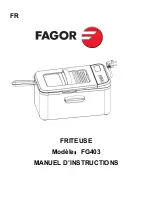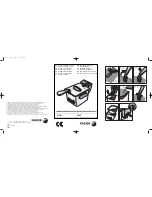
TECH SHEET - DO NOT DISCARD
PAGE 7
10251191A
W
.
O
N
T
R
A
P
Y
L
N
O
E
S
U
S
’
N
A
I
C
I
N
H
C
E
T
E
C
I
V
R
E
S
R
O
F
TEST #4a
Thermistors
Outlet Thermistor
The machine control electronics monitors the
exhaust temperature using the outlet thermistor,
and cycles the heater relay on and off to maintain
the desired temperature.
Begin with an empty dryer and a clean lint screen.
1.
Plug in dryer or reconnect power.
2.
Start the Timed Dry cycle.
3.
If after 60 seconds,
F:22
or
F:23
flashes in the
display and the dryer shuts off, the thermistor
or wire harness is either open or shorted.
Unplug dryer or disconnect power.
Check wire connections at the machine
control electronics and thermistor. See
Accessing & Removing the Electronic
Assemblies, page 9, and for thermistor
location, see figure 11, page 6.
If wire connections are OK, check the outlet
thermistor resistance per step 5.
4.
If
F:22
or
F:23
does not flash in the display,
the connections to the thermistor are good.
Therefore, check the exhaust temperature value
at any or all of the temperature levels in
question, using the Timed Dry cycle, and the
following process:
Hold a glass bulb thermometer capable of
reading from 90° to 180°F (32° to 82°C)
in the center of the exhaust outlet. The correct
exhaust temperatures are as follows:
EXHAUST TEMPERATURES
TEMPERATURE
SETTING
HEAT TURNS OFF*
°F
(°C)
HEAT TURNS ON
°F
(°C)
High
155°±5° (68°±3°) 10–15° (6–8°)
below the
heat turn off
temperature
Medium
140°±5° (60°±3°)
Low
125°±5° (52°±3°)
Extra Low
105°±5° (41°±3°)
*
The measured overshoot using the glass bulb
thermometer in the exhaust outlet can be 30°F
(17°C) higher.
5.
If the exhaust temperature is not within
specified limits, or you have come here
from step 3, perform the following:
NOTE:
All thermistor resistance measurements
must be made while dryer is unplugged or
disconnected from power.
ELECTRIC DRYER:
Remove the P4 connector,
then measure the resistance between P4-3
(red wire) and P4-6 (red wire) at the connector.
If the resistance is OK, check P4-3 and P4-6
to dryer ground.
If resistance is greater than 0 (zero), replace
wiring harness.
GAS DRYER:
Remove the P14 connector,
then measure the resistance between P14-3
(red-white wire) and P14-6 (red-white wire)
at the connector.
If the resistance is OK, check P14-3 and
P14-6 to dryer ground.
If resistance is greater than 0 (zero), replace
wiring harness.
ALL DRYERS:
The following table gives temperatures and
their associated resistance values.
OUTLET THERMISTOR RESISTANCE
TEMP.
°F
(°C)
RES.
RANGE
k
Ω
TEMP.
°F
(°C)
RES.
RANGE
k
Ω
50° (10°) 19.0–22.0
80° (27°) 8.5–10.5
60° (16°) 14.8–16.8
90° (32°)
6.8–8.8
70° (21°) 11.5–13.5 100° (38°)
5.0–7.0
If the thermistor resistance does not agree
with table, replace the outlet thermistor.
If the thermistor resistance checks agree
with the measurements in the table, replace
the machine control electronics.
Inlet Thermistor, Electric Dryer
The machine control electronics monitors the inlet
temperature using an inlet thermistor that is part
of the high limit thermostat assembly.
1.
Activate the Diagnostic Test Mode. See
procedure on page 1.
2.
If
F:24
or
F:25
is a displayed error in the
Diagnostic Test Mode, the inlet thermistor
or wire harness is either open or shorted.
Unplug dryer or disconnect power.
Check wire connections at the machine
control electronics and inlet thermistor.
See Accessing & Removing the Electronic
Assemblies, page 9, and for inlet thermistor
location, see figure 11, page 6.
If wire connections are good, remove the
wires from the inlet thermistor/high limit
thermostat assembly and replace the
assembly.
Plug in dryer or reconnect power.
3.
If
F:24
or
F:25
is not an error that is displayed
in the Diagnostic Test Mode, the connections to
the thermistor are good. Therefore, check the
thermistor’s resistance value, using the
following process:
Unplug dryer or disconnect power.
Access the heater assembly. See figure 2,
page 3; and Removing the Toe Panel,
page 9.
Hold a glass bulb thermometer capable
of reading from 68° to 176°F (20° to 80°C)
in the heater assembly.
Check the resistance of the inlet thermistor.
See figure 11, page 6, for location.
The following table shows the resistance
values that should be observed for the various
temperatures at the heater assembly.
INLET THERMISTOR RESISTANCE
TEMP.
°F
(°C)
RES.
RANGE
k
Ω
TEMP.
°F
(°C)
RES.
RANGE
k
Ω
68° (20°) 61.2–63.7 131° (55°) 14.6–15.3
77° (25°) 49.0–51.0 140° (60°) 12.1–12.8
86° (30°) 39.5–41.1 149° (65°) 10.2–10.7
95° (35°) 32.0–33.3 158° (70°)
8.5–9.0
104° (40°) 26.1–27.2 167° (75°)
7.2–7.6
113° (45°) 21.4–22.3 176° (80°)
6.1–6.5
122° (50°) 17.6–18.5
If the thermistor resistance does not agree
with the measurements in the table, replace
the inlet thermistor/high limit thermostat
assembly.
If the thermistor resistance agrees with
the measurements in the table, replace
the machine control electronics.
TEST #4b
Thermal Fuse
ELECTRIC DRYER:
The thermal fuse is wired
in series with the dryer drive motor.
GAS DRYER:
The thermal fuse is wired in series
with the dryer gas valve.
ALL DRYERS:
1.
Unplug dryer or disconnect power.
2.
Access the thermal fuse by first removing the
toe panel. See Removing the Toe Panel, page 9;
and for thermal fuse location, see figure 11,
page 6.
3.
Using an ohmmeter, check the continuity
across the thermal fuse.
If the ohmmeter indicates an open circuit,
replace the failed thermal fuse.
TEST #4c
Thermal Cut-Off
If the dryer does not produce heat, check the
status of the thermal cut-off.
1.
Unplug dryer or disconnect power.
2.
Access the thermal cut-off by first removing
the toe panel. See Removing the Toe Panel,
page 9.
3.
Using an ohmmeter, check the continuity
across the thermal cut-off. See figure 11,
page 6, for location.
4.
If the ohmmeter indicates an open circuit,
perform the following:
ELECTRIC DRYER:
Replace the failed
thermal cut-off and inlet thermistor/high limit
thermostat assembly. In addition, check for
blocked or improper exhaust system, or failed
heat element.
GAS DRYER:
Replace the failed thermal cut-off
and high limit thermostat. In addition, check for
blocked or improper exhaust system.






























